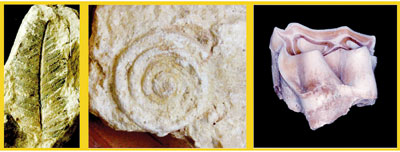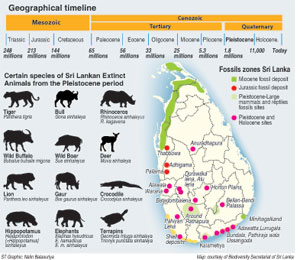News
Protect Sri Lanka’s Jurassic Park
Millions of years ago, lions, tigers, rhinos, hippos and, perhaps, even dinosaurs, roamed our land, but unlike man-made archaeological artifacts, sites where fossils are buried do not get enough protection, experts have lamented. They expressed their concern at the recently-concluded Archaeological Congress of Sri Lanka where the Sri Lanka Biodiversity Secretariat handed over a proposal to the Archaeology Department on the need to amend the Archaeological Act to protect fossil deposits of Sri Lanka.

Fossils found in Sri Lanka: From left, a part of a fossilised Nilssonia Fissa plant belong to the Jurassic era, Fossilied Conus, a species belonging to the Miocene period and a fossilised tooth of an animal that lived in the Pleistocene era.
The congress was told that millions of years old fossil deposits belonging to the Jurassic, Miocene and Pleistocene periods had been unearthed at Tabbowa in the Puttalam district and other places by archaeologists, but many of these sites were left unprotected and vulnerable to the elements.
The experts said that just as much the way steps were being taken to protect archaeological sites from criminals, millions of years old nature’s creations should be protected before they got lost without anybody’s knowledge.
According to Kelum Manamendra-Arachchi, one of the few experts involved in palaeobiology and palaebiodiversity or the study of fossilised animals and plants, the Tabbowa Jurassic fossil deposits are of the animals that lived some 213 million to 144 million years ago. They had remained preserved in mud and silt stones underground while one deposit was found on the surface of the earth near the Tabbowa tank.
He pointed out that deposits found on the surface should be protected particularly as they were vulnerable to the elements. They included fossilised plants such as conifers, cycade and ferns belonging to the Jurassic era – the period during which dinosaurs roamed the earth.
“So if there were plants from the Jurassic era, there is a big possibility that dinosaurs too roamed this land millions of years ago,” the palaeobiologist said. “Therefore, these fossils need to be protected,”Mr. Manamendra-Arachchi said. Fossils that belong to the Miocene period 25 million years ago are also found in Sri Lanka. Jaffna, the North Western and South Eastern regions are known to be containing Miocene deposits. Fossilised remains of several marine species belonging to this era have been found in the Aruwakkalu areas in Puttalam during excavation for lime for cement production.

Jaffna’s limestone rich areas also contain Miocene fossil deposits. These fossils range from gastropod mollusks to fossils of ancient turtles, sharks, dolphins and even whales. However, the most interesting fossils from Sri Lanka belong to the Pleistocene era that dates back to 2 million years.
The Pleistocene era is the last ice age and marked the arrival of modern man and other modern biological diversity. Fossilised bones belonging to a lion, a crocodile, two species of rhinoceros, a hippopotamus, a gaur, a tiger, a wild boar, a bull, a wild buffalo, a deer have been found in various parts of Sri Lanka,
The remains of a species, a close relative of the modern elephant, have been found in gem pits in Ratnapura and they are internationally knowsn as ‘Ratnapura Fauna’. “Ratnapura is surrounded by mountains. So the animals that died millions of years ago must have been washed into this area, remain buried under mud and got fossilised,” Mr. Manamendra-Arachchi said explaining why there were high incidences of fossils discovery in the Ratnapura area.
“These fossils have been preserved in this alluvial plain which is a landform created by the deposition of sediment over a long period by one or more rivers coming from highland regions. There could be animals that lived in other areas too and their bodies had washed into the ocean over a long period of time or decayed owing to the influence of natural elements,” the palaeobiodiversity expert said.
All living beings have scientific names and even these fossilised animals that lived millions of years ago have been given interesting names.
Mr. Manamendra-Arachchi explained the process of scientifically classifying a fossilised animal. Usually the fossilised bone or the part of it is first compared with a living animal. If a match cannot be found, then it is compared with similar fossils found from the region. If no match is found, then the fossil is considered to be a new species and is given a scientific name. The pioneer of this field is P.E.P. Deraniyagala. His effort has made Sri Lanka an internationally important destination for the search of missing links of biodiversity.
Palaeobiodiversity
Fossils are evidence of past life. This broad definition includes standard shells, bones, petrified wood, and leaves. However, there are many more things that can become fossils: footprints, pollen, feeding traces, worm burrows, even fossilsed faeces.
The study of ancient biological diversity is known as paleobiodiversity (pura jaivavividathwaya in Sinhala). The word paleobiodiversity itself is a tongue twister and a new word for our vocabulary. The Biodiversity Secretariat that operates under Department of Environment has been doing a commendable work in popularising paleobiodiversity. It recently organised a public lecture by Mr. Manamendra-Arachchi.
Follow @timesonlinelk
comments powered by Disqus

